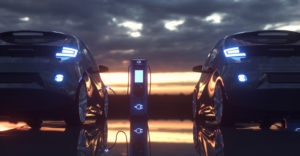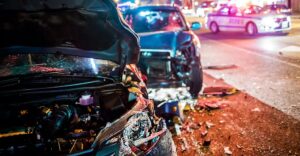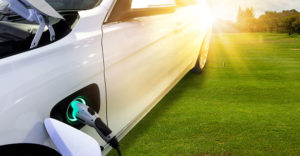Thanks to Google, self-driving passenger cars have gained a lot of media attention, but the immediate future of driverless vehicles may lie in home deliveries.
Starship Technologies in 2016 will launch two pilot projects — one in the UK and one in the United States — to test a driverless vehicle designed to make short-distance deliveries.
The vehicle, which looks like an oversized slow cooker on wheels, can carry loads equivalent to two bags of groceries from a distribution center or retail outlet to customers.
The unit is equipped with GPS so customers can track the progress of their deliveries in real time. When the vehicle arrives at the doorstep, a customer can unlock it using a smartphone.
Although the vehicles are on autopilot 99 percent of the time, human operators are monitoring them. The operators can take manual control of the vehicles in a pinch and speak to people through speakers built into them.
Delivery by conventional means is 10 to 15 times higher than the cost of delivery by delivbots, Starship estimated.
Better Than Drones
What Starship and others looking at driverless delivery solutions are grappling with is one of the biggest problems facing logistics companies today: reducing the cost of the last mile in the delivery chain.
“In the logistics space, that last mile is by far the most expensive part of delivery,” said Tom Caporaso, CEO ofClarus Commerce.
“So you’re seeing folks take some stabs at innovation to get a product in people’s hands at the lowest cost,” he told TechNewsWorld.
Amazon has garnered a lot of notice by exploring the use of flying drones as a solution to the final-mile problem, but driverless vehicles have benefits drones don’t have.
Self-driving delivery vehicles are more economical than drones, maintained Michael Kay, co-director of operations research in theIndustrial Systems and Engineering Department at North Carolina State University.
“If you want to have home delivery for almost everything and eliminate almost any required trips to the store, then, to do that cost effectively, you really have to have ground transport,” he told TechNewsWorld.
“Drones are fine for high-priority, high-value products, but your typical gallon of milk kind of thing, it’s not as economical to do with a drone as it is with surface technology,” Kay added.
Dumb Luck
In the future, 80 to 85 percent of all deliveries to the home will be made by self-driving vehicles, Kay predicted. “In 15 to 20 years, you’ll never have to leave your home for any type of shopping.”
In his vision of the future, driverless delivery vehicles would be bigger than Starship’s, and they’d travel on roads. Starship’s vehicles are designed to travel on sidewalks.
“Operating on sidewalks probably makes sense in other countries but not for the U.S.,” Kay said. That’s because of the density of development in the United States compared to Europe.
Low-density development in the United States makes it fertile for self-driving technology, he noted.
“The smartest thing the U.S. has ever done is not develop a lot of expensive public transport,” Kay said.
“It’s dumb luck that driverless cars are coming that will save our skin and be better in the long run in terms of flexibility,” he added.
Driverless Delivery Net
All the technology that’s in a self-driving passenger car could be adopted for self-driving delivery vehicles. “The freight stuff would be a great first use of the technology,” Kay said.
He is researching distribution networks for self-delivery vehicles. The networks would be made up of distribution centers. Each center would serve about 2,000 homes, so vehicle trips would be very short — 1 to 2 miles.
The vehicles would be used for delivery to the home during the day, but during evening hours, they could be used to transport items between distribution centers.
“So if you order something available 10, 15 miles from your home, then overnight it would travel through the network so the next day it would only be a mile or two away,” Kay explained.
The vehicles for the network would be small enough to be economical to deliver directly to a home but large enough — 1,000 pounds or so — to travel on a public roadway.
“It won’t have to stop at multiple places,” Kay said. “It wouldn’t be like UPS where a vehicle has to stop at multiple homes making small deliveries. The vehicle could be small enough so it can be dedicated to you.”
Soulless Delivery
His network would be vendor-neutral, so existing logistics companies could plug into it, much as anyone can connect to the Internet.
“IBM doesn’t have to run the Internet. You can specify standards for a router, and any company can build one and add it to the Internet,” Kay said.
“My research has been to come up with general protocols and methodologies that are not specific to a particular company,” he explained. “That would allow even small companies to have some of the same capabilities and access to the same services that even larger companies would have.”
As automation starts to take hold in the last mile of delivery, it remains to be seen how the public will react to seeing its friendly neighborhood delivery person replaced by a soulless machine.
“Acceptance is going to probably be the biggest hurdle with some of these newer innovations,” Clarus’ Caporaso said.
‘Jetsons’ World
“One of the things I imagine they’ll be studying is how people react to these unmanned vehicles,” said Roger C. Lanctot, associate director for the global automotive practice atStrategy Analytics.
“Do they push them over? Do they drop things in front of them? Will people be hostile to them?” he told TechNewsWorld.
If the past is any window on the future, however, public acceptance will be a short-lived barrier to adoption.
“While these delivery robots sound a little bit like The Jetsons, I think you’ll see them sooner rather than later — in the next couple of years,” Caporaso said.
“I hope to be telling my grandkids about how people had to go to stores and load up cars with all this stuff,” said Kay. “Hopefully, it will seem as strange to them as trying to talk to someone today about how they lived before smartphones.”























































Having semi-autonomous vehicles running around sidewalks and taking shortcuts through parks will spawn an entire new category of law. The real winners of the future autonomous world will be the artificial-intelligence based lawyers.